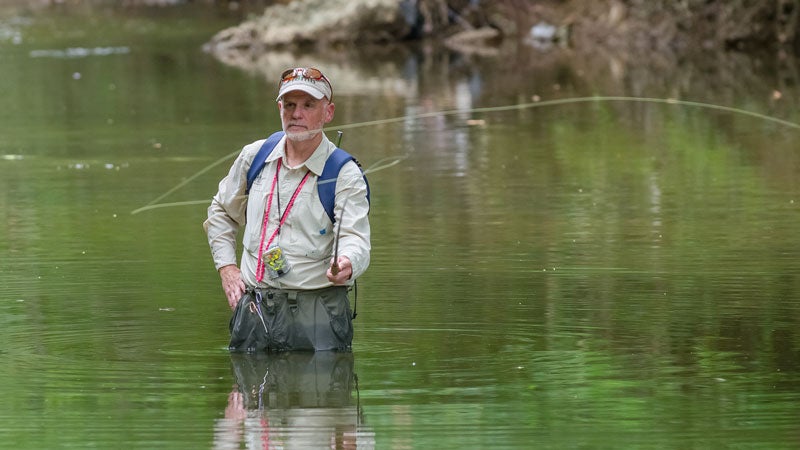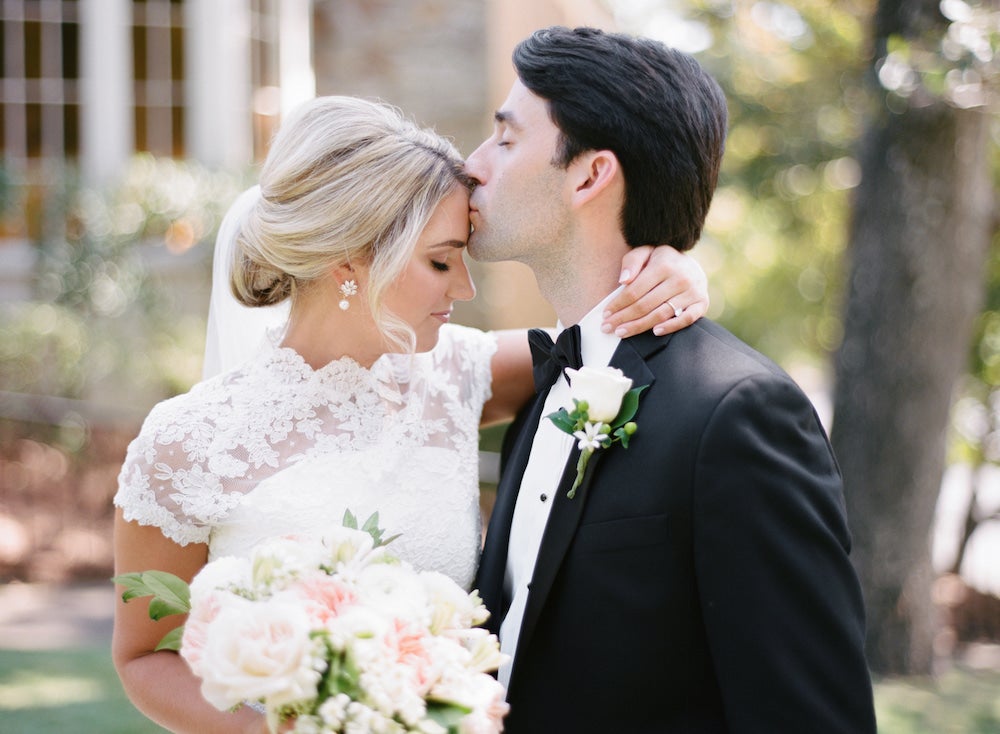From its headwaters between Birmingham Race Course and a cement plant, to the place it meets the Cahaba River near Montevallo, Shades Creek is an entirely urban stream. It flows through nearly 55 miles and six municipalities and provides a home for at least two endangered species of fish. It even has its own strand of the Cahaba lily. Despite its impressive resume, however, it’s often regarded as little more than a drainage ditch. That’s a perception Mountain Brook resident and fly fisherman Stuart Roberts enjoys seeing change.
“I know people view Shades Creek as an urban runoff stream,” Stuart says. “I’m always surprised how that attitude changes once someone has stood in the middle of Shades Creek for a couple of hours. I love taking people out fishing for the first time. They always have the same reaction.”
Once it winds through Mountain Brook Country Club and Jemison Park, Shades Creek deepens as it runs along Shades Creek Parkway. Although it runs along one of the busiest thoroughfares in the area, noise from the traffic all but disappears as you climb through the dense underbrush down into the water to fish. You might as well be 50 miles south in a much-less populated area of the Cahaba when you’re up to your waist in Shades Creek fishing. It’s an illusion that lasts until you start picking up golf balls from Mountain Brook Country Club and sporting equipment from nearby athletic fields. One afternoon, Stuart even carried out a 50-gallon trash can. That was a new one for him.
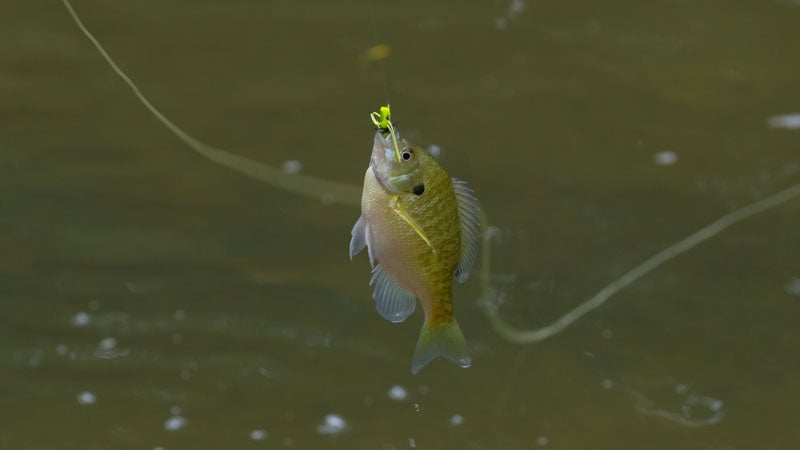 The warm water of Shades Creek is a habitat for bluegill and other bream as well as some bass. Bluegill nests are readily visible in shallow parts of the creek, but Stuart is partial to the green sunfish that has the body of a panfish and the big mouth of a bass. Despite looking like it was assembled from “leftover parts,” as Stuart says, it’s a fish with aquarium good looks that’s a fairly frequent catch in Shades Creek.
The warm water of Shades Creek is a habitat for bluegill and other bream as well as some bass. Bluegill nests are readily visible in shallow parts of the creek, but Stuart is partial to the green sunfish that has the body of a panfish and the big mouth of a bass. Despite looking like it was assembled from “leftover parts,” as Stuart says, it’s a fish with aquarium good looks that’s a fairly frequent catch in Shades Creek.
What equipment is appropriate for these catches in the creek? Stuart frequently uses a Tenkara rod that that uses only a telescoping fly rod with a relatively short attached line and fly. Traditional fly rods employ a reel that spools approximately 125 yards of weighed fly line and backing. The portability of the Tenkara rod makes it easy to use for a few minutes of quick before-and-after-work fishing in a stream, not so unlike the Japanese freshwater trout streams it was developed for nearly 200 years ago. Stuart also touts the Tenkara rod as being more intuitive and easier to learn than a traditional fly rod. His ease with it is apparent and his accuracy enviable as he spots a fish in a dark edge of the creek and delivers the fly right to the front door.
Shades Creek remains at a near-comfortable temperature for wet-wading almost year round. Stuart fishes a couple of times a week late into the season. “I usually quit fishing for the year around December 31,” he quips.
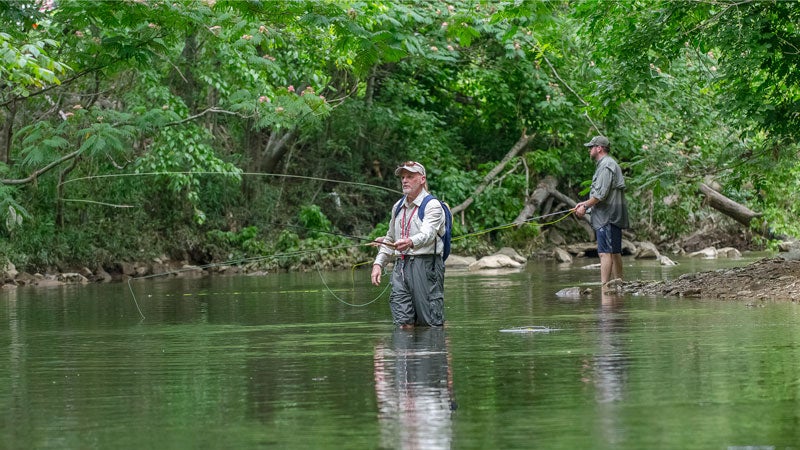 Stuart’s journey in the creek all started in 2008 when he was working in the First Commercial Bank building on Shades Creek Parkway. “Wednesday afternoons my kids would go to choir practice at Office Park,” he says. “The choice was simple: I could stay another hour in the office and work, or I could go fishing in Shades Creek. I knew there were fish in Shades Creek once again thanks to the kids. We would ride bicycles across the bridges and always stop for a fish look. My rule for fishing is just fish when you can.”
Stuart’s journey in the creek all started in 2008 when he was working in the First Commercial Bank building on Shades Creek Parkway. “Wednesday afternoons my kids would go to choir practice at Office Park,” he says. “The choice was simple: I could stay another hour in the office and work, or I could go fishing in Shades Creek. I knew there were fish in Shades Creek once again thanks to the kids. We would ride bicycles across the bridges and always stop for a fish look. My rule for fishing is just fish when you can.”
While many people might not even consider the warm creeks of Alabama suitable for fly fishing, a growing number of people are starting to know better. Bluegill are plentiful and fun to catch on the fly, and the temperature of the water, while making Alabama streams unsuitable for trout, makes wet-wading in the summertime a singular pleasure. “If this creek were in Colorado, it would be shoulder-to-shoulder all summer,” Stuart says, quoting a friend.
Shades Creek’s urban location magnifies its accessibility to fishermen, but it also creates ecological vulnerability. Much like the Cahaba River, Shades Creek is threatened by sediment runoff from development and invasive plant species. Friends of Shades Creek and Friends of Jemison Park in Homewood and Mountain Brook, respectively, often partner to advocate for Shades Creek and to help educate the community about protecting and caring for it.
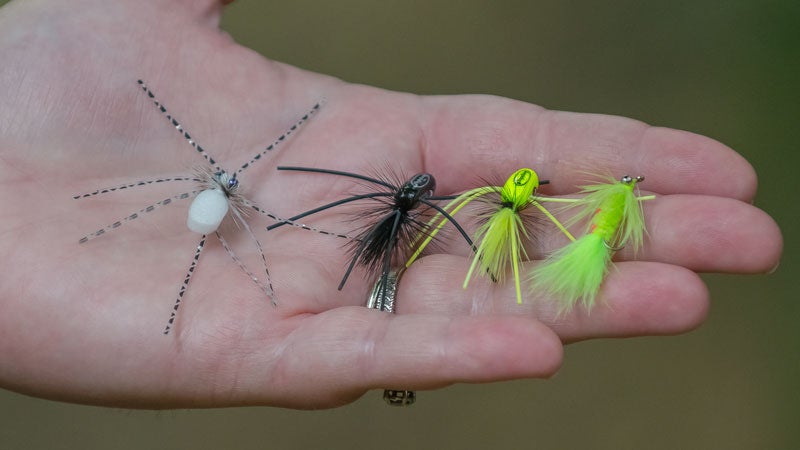 Among its advocates is Sim S. W. Johnson, who became interested in native plant species when his family bought a house near Jemison Park. Now president of Friends of Jemison Park, he tirelessly promotes the reintroduction of native plants to the area surrounding Jemison Park and for the health of Shades Creek.
Among its advocates is Sim S. W. Johnson, who became interested in native plant species when his family bought a house near Jemison Park. Now president of Friends of Jemison Park, he tirelessly promotes the reintroduction of native plants to the area surrounding Jemison Park and for the health of Shades Creek.
In many ways, Sim’s devotion to the preservation of this 54-acre plot is part of Mountain Brook’s DNA. Developer Robert Jemison reserved the low-lying area around Shades Creek for a nature preserve when the city was first being plotted. Now, Sim’s efforts to replace invasive Chinese privet with more native species of plants and trees is helping to preserve the enclave of natural Alabama beauty that Jemison intended.
To that point, this spring Friends of Jemison Park partnered with Friends of Shades Creek along with a number of other Alabama conservation and land-preservation organizations to host Shades Creek Fest, a family-friendly event with music and free fly fishing for children that was sponsored by Caliber, an outdoor store in Homewood. Nearly 400 people attended, and plans are already in the works for a 2019 event.
Like Stuart, Sim seems to understand that introducing the community to the often-overlooked wonders of a particular natural treasure is often all it takes to motivate them to be conservation-minded. “I think people really want to take care of the creek. We’ve just got to simplify that and make it as easy as possible,” Sim says.
But one thing about Shades Creek that can’t be simplified any further is the way Stuart fishes it. Between now and the time he hangs up his wading boots for the year on December 31, he’ll be out when he can with his Tenkara rod wet-wading and enjoying the truly unique ecosystem surrounding Shades Creek. He’ll be on the lookout for spotted bass, bluegill, red breasted sunfish and green sunfish. He’s likely to spot pretty much every species of fresh-water turtle that lives in Alabama and a variety of small mammals like beaver or even mink. And come New Year’s Day, he’ll start all over again.

